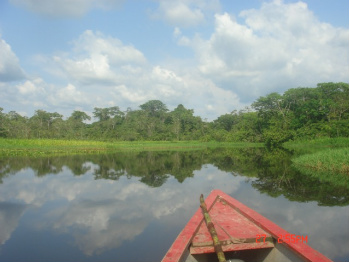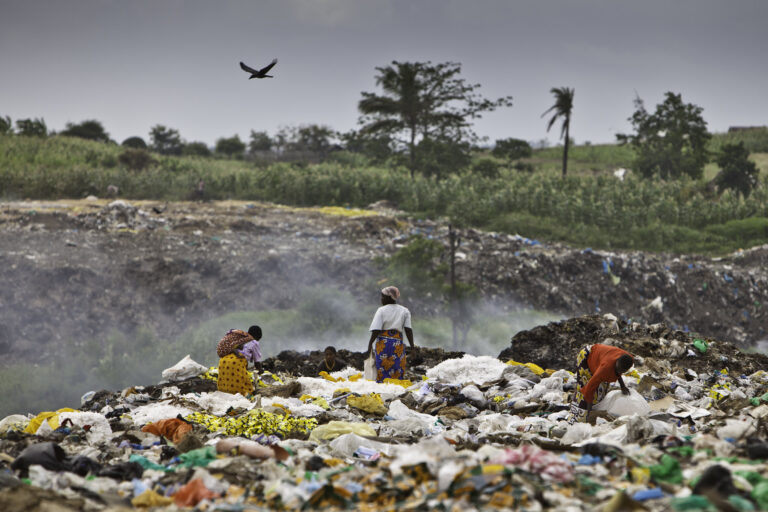Ecuador’s Yasuni National Park is full of wealth: it is one of the richest places on earth in terms of biodiversity; it is home to the indigenous Waorani people, as well as several uncontacted tribes; and the park’s forest and soil provides a massive carbon sink.
However, Yasuni National Park also sits on wealth of a different kind: one billion barrels of oil remain locked under the pristine rainforest. While drilling for oil has brought huge profits–the commodity is Ecuador’s top export–it has also brought environmental destruction and conflicts with indigenous groups, including a legal one between several tribes and Chevorn highlighted by the new film Crude.
In a country where oil extraction has a long, bloody, and contentious past, President Rafael Correa put forth a novel idea, known as the Yasuni-ITT Initiative. He announced in 2007 that he would not touch the oil if the international community compensated Ecuador. He said that leaving the oil would help achieve three international objectives: protecting biodiversity, respecting the rights of indigenous people, and combating climate change, since it is estimated that extracting the oil would release 410 million metric tons of carbon.
“Oil and gas concessions now cover vast swaths of the mega-diverse western Amazon. Ecuador´s revolutionary initiative is the first major government-led effort to buck this disturbing trend,” says Dr. Matt Finer from Save America’s Forests. Finer is the lead author of a new paper in Biotropica that looks at the viability of Yasuni-ITT, and the hurdles it will have to jump to even be implemented.

Yasuni National Park in Ecuador. Photo by Matt Finer © Save America’s Forests. |
The most difficult hurdle is how to get paid for leaving oil instead of selling it. At first Ecuador, with an economy largely dependent on oil, asked international countries for compensation of around 350 million US dollars per year (about half of what could be expected from the oil). However, after several deadlines—and two years—passed without raising the funds, Ecuador has now turned to the burgeoning carbon market by offering ‘Yasuni Guarantee Certificates’. Yet as the Biotropica paper points out this means that the initiative would not result in a net less in carbon, since nations and companies would likely offset continuing pollution.
“The best way to minimize the risk associated with the carbon bonds is to encourage supporters to make direct donations,” said Remi Moncel of the World Resources Institute. “While less problematic from the point of view of environmental integrity, it is harder to raise money that way.”
Yasuni-ITT is an example of just how difficult such donations are. Germany has been the largest verbal supporter of Yasuni-ITT. Numbers have been tossed around, but the nation has yet to put forward any real money and recent reports suggest that Germany may be backing-off original promises. Other European nations have shown interest including Spain and France.
Despite the difficulties facing Yasuni-ITT—including making certain that countries compensating Ecuador won’t decide to drill for themselves in the future—the researchers believe that Yasuni-ITT will become a model both for oil and gas drilling in areas where it would lead to environmental degradation, biodiversity loss, or local conflict, that is, should it succeed. As well, the authors say, Yasuni-ITT should be looked at as a creative way to combat climate change.
“The climate conference of Copenhagen is only weeks away. What Ecuador has proposed is a good example of how each country can come up with home-grown, nationally relevant ideas to promote sustainable development,” Moncel said.
Dr. Clinton Jenkins of the University of Maryland says that the future of Yasuni national Park will ultimately rest on the value’s of global society: “Yasuní is an exceptional place in the world, biologically incredible, home to uncontacted peoples, and yet – perhaps tragically – full of oil. Society faces a test of what we value more, drilling for more oil, or preserving a cherished national park and the people who call it home.”
In terms of biodiversity Yasuni National Park supports 150 amphibian species and 121 reptiles (the highest numbers of herpetofauna on earth), in addition to 600 species of bird and 200 mammals. Such numbers are always changing, since new species are discovered frequently.
The reserve is also home to the Waorani people. In the past the warlike tribe often defended their homes violently: they became famous for spearing oil workers, missionaries, and illegal loggers, while the infringement on their territory by the wider world led to several epidemics and cultural upheaval. Tribes—both related and only distantly related to the Waorani—still remain uncontacted in the park today, such as the Tagaeri and Taromenane.
Due to the unique place that Yasuni National Park holds not just for Ecuador (it’s the country’s only Amazonian park), but for the world, it was designated a Man and Biosphere Reserve by UNESCO in 1989.
Citations:
Matt Finer, Remi Moncel, and Clinton N. Jenkins. Leaving the Oil Under the Amazon: Ecuador’s Yasuni –ITT Initiative. Biotropica, October 2009. 10.1111/j.1744-7429.2009.00587.x.
Matt Finer, Varsha Vijay, Fernando Ponce, Clinton N Jenkins, and Ted R Kahn. Ecuador’s Yasuni Biosphere Reserve: a brief modern history and conservation challenges. Environmental Research Letters 4 (2009) 034005.
Related articles
Amazon tribes have long fought bloody battles against big oil in Ecuador

(09/03/2009) The promotional efforts ahead of the upcoming release of the film Crude have helped raise awareness of the plight of thousands of Ecuadorians who have suffered from environmental damages wrought by oil companies. But while Crude focuses on the relatively recent history of oil development in the Ecuadorean Amazon (specifically the fallout from Texaco’s operations during 1968-1992), conflict between oil companies and indigenous forest dwellers dates back to the 1940s.
Germany to pay Ecuador $650 million to forgo oil drilling, protect rainforest reserve
(09/03/2009) Germany has apparently agreed to fund a significant portion of Ecuador’s scheme to leave Amazon rainforest oil reserves in the ground, according to Business Green.
Chevron expects to lose $27B suit but will refuse to pay damages
(07/22/2009) Chevron Corp. expects to lose a multibillion dollar environmental lawsuit in Ecuador but has no intention of paying damages and will continue to fight for “decades”, reports the Wall Street Journal.
Chevron faces shareholder rebuke on claims by Amazon rainforest Indians
(05/21/2009) Calpers, the country’s largest public pension fund with $170 billion in assets, announced Thursday it will support a resolution calling on Chevron to examine whether it complies with environmental regulations in Ecuador. The move comes as the oil giant faces a potential $27 billion dollar liability for environmental damage caused by Texaco, a company Chevron (NYSE:CVX) acquired in 2001. In court filings Texaco has admitted to dumping and spilling billions of gallons of toxic waste and oil in eastern Ecuador’s Amazon rainforest between 1964 and 1990.
14,000-barrel oil spill in the Ecuadorean Amazon
(02/27/2009) A ruptured oil pipeline caused 14,000 barrels of crude to spill into a river in the Napo region in northeast Ecuador, an area known for its high biological diversity, reports Reuters.
Payments for eco services could save the Amazon

(02/12/2009) Paying for the ecological services provided by the Amazon rainforest could be the key to saving it, reports a new analysis from WWF. The study, Keeping the Amazon forests standing: a matter of values, tallied the economic value of various ecosystem services afforded by Earth’s largest rainforest. It found that standing forest is worth, at minimum, $426 per hectare per year.
Ecuador’s plan to protect rainforest from oil drilling looks doomed
(10/09/2008) Ecuador’s proposal to protect one of the world’s most biodiverse rainforests from oil development has failed to secure any funding ahead at its December deadline, reports the Guardian Unlimited.
Chevron loses attempt to reduce payment in suit by Amazon rainforest natives
(10/08/2008) Chevron lost its attempt to force arbitration in a case in which it could be liable for billions of dollars to pay for cleaning up damages to the Amazon rainforest in eastern Ecuador.
Oil development could destroy the most biodiverse part of the Amazon
(08/12/2008) 688,000 square kilometers (170 million acres) of the western Amazon is under concession for oil and gas development, according to a new study published in the August 13 edition of the open-access journal PLoS ONE. The results suggest the region, which is considered by scientists to be the most biodiverse on the planet and is home to some of the world’s last uncontacted indigenous groups, is at great risk of environmental degradation.
Chevron lobbies Bush Administration for bail out on lawsuit by Amazon tribes
(07/31/2008) Lobbyists for big oil are working feverishly to persuade the Bush Administration and Congress to let Chevron off the hook for a potential $16 billion liability in an environmental lawsuit.
Ecuador: pay us not to develop Amazon oil reserves
(04/27/2007) Ecuador says it will wait a year to see whether the international community takes its offer to forsake development of a giant oil field in the Amazon rainforest in exchange for compensation, reports the Environmental News Service.
Chevron shareholders may be liable for billions in environmental damages
(04/25/2007) The lead lawyer in the landmark environmental lawsuit against Chevron in Ecuador is in California to warn that the oil major has failed to prepare for a possible multi-billion dollar damages bill within the coming months














